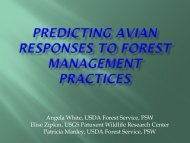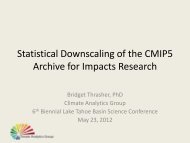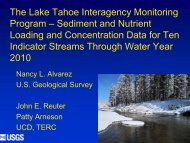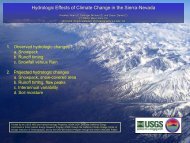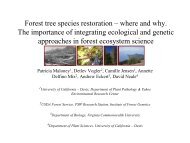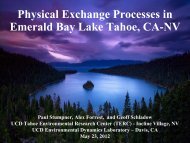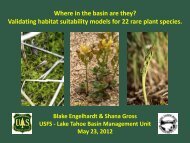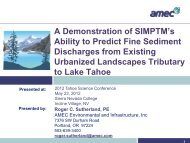Anderson, Lars W.J
Anderson, Lars W.J
Anderson, Lars W.J
You also want an ePaper? Increase the reach of your titles
YUMPU automatically turns print PDFs into web optimized ePapers that Google loves.
Dye Movement in the Tahoe Keys:Implications for Management of Aquatic Invasive Species UsingIntegrated Methods<strong>Lars</strong> <strong>Anderson</strong> (USDA-ARS Retired)Acknowledgements:Tom McNabb and Tom Moorhouse (Clean Lakes)Ben Bradford & Vanessa Guzman (USDA- ARS), Tahoe KeysProperty Owners Association, Tahoe Regional Planning Agency,Lahontan Regional Water Quality Control Board, Tahoe ResourceConservation District
Topics:• Aquatic Plant Management Context at Tahoe• Need to expand the current management tool kit• Rhodamine WT as herbicide “surrogate” approach• Results and Implications
“Wicked Environmental Problems”Managing Uncertainty and Conflict*• “...a high degree of scientific uncertaintyand a profound lack of agreement onvalues, combined with the absence of aperfect solution…”• Solution: “Learning Networks”• Consilience in Beliefs>Actions>Solutions(L. <strong>Anderson</strong>…2012)*Peter J. Balint, Ronald E. Stewart, Anand Desai, Lawrence C Walters2011, Island Press. 253 p.
Lake Tahoe Exotic Aquatic Species Introduction (Detection) TimelineEstablishment of lake troutbrown, rainbow,brook, lake troutcrayfishkokaneeMysisEurasianwatermilfoil?bass spp.Curlyleafpondweed1st ZebramusselInterdiction onboat- preventedfrom launching?AsianclamAsianclamRemovalbegunRESPONSES1880 1900 1920 1940 1960 1970 1980 1995 2003 2006 2007 2008 2011extirpation of cutthroat trout & Daphnia spp.After Sudeep Chandra (Univ.Nev-Reno); modified andupdated by <strong>Lars</strong> <strong>Anderson</strong> (USDA-ARS-Davis, CA)USDA-ARS:WholeLake Plant SurveysAIS WorkingGroupARS-TRCDOrg. AISWorkshopAIS CoordinatingCommittee; TRPA &USFWS CoordinatorsAIS PlanApproved2009,TRPA andUSFWSappointAIScoordinatorTahoeKeysProjectStarted
Adaptive Integrated AIS ManagementMaximize efficacy through an optimalchoice and timing of control methodsMinimize adverse impactsCoordinate actions to facilitatemanagement of all AIS taxa Document and assess impacts ofmanagement actionsAdjust future management actions
Non-native and nuisance plants in the Tahoe Keys:• Eurasian watermilfoil (Myriophyllum spicatum)• Curlyleaf pondweed (Potamogeton crispus)• Native Coontail (Ceratophyllum demersum)M. spicatum P. crispusP. crispus turions:Produced in earlysummer;Sprout in fall
Eurasian watermilfoil-Lake Tahoe December-2008“Andian milfoil” (native)Myriophyllum quitense
Current Prevention Measures• Vessel Inspections: No inspector = Nolaunch• Mandatory inspection (TRPA)• Extensive Inspection & Decontamination(Major Highway Stations)• CDFG Code 2301• $5000 fine for decontamination refusal• Signage, fliers, workshops• Other public outreach Examples of Signage:
Current AIS Management Tools• Harvesting• Hand-pulling• Benthic barriers• Diver-assisted• Electro-shocking (warmwaterfish removal)Photo: <strong>Lars</strong> <strong>Anderson</strong>• No Herbicides orMolluscicides permittedat this timePhoto: <strong>Lars</strong> <strong>Anderson</strong>Photo: Brant Allen 2008
New Tools for IPM at Tahoe ?Potential for Use of Aquatic Pesticides-Proposed Basin Plan AmendmentLahontan Regional Water Quality ControlBoard Approved Basin Plan Changes (2011) State Water Resources Board Approved 2012Federal EPA review- Summer 2012? Rhodamine WT Study: 2011-2012
Specific Objectives of Tahoe Keys Project‣ Compare/ Assess Efficacy and Impacts of Bottom Barriers vs.Standard Cutting/Harvest/Remova‣ Determine Movement and Dissipation ofRhodamine WT (dye) as a Surrogate forAquatic Herbicides.‣ Obtain Baseline Data on Benthic Invertebrates (sediment sampling).‣ Determine Feasibility of Using Mechanical Removal Methods toManage Non-Native Warmwater FishOutcomeDevelop BMPs for AIS Management at Tahoe Keys (and Lake Tahoe)Provide Basis for Any Future Applications for Using Aquatic HerbicidesProvide Background Data for Subsequent Programmatic EIR/EIS
Tahoe Keys
Each flag is a GPSreferencedsampleUSDA -ARS Tahoe Keys Survey: May 21, 22, 2009315 Samples Taken (includes 266 samples in the West Basin)Number Codes for Each Area Sampled (See bar graphs below)Tahoe Keys sampled 5/21 and 5/22/0922716654181721151420191312111098321Presence/absenceSummaryEurasianwatermilfoilCoontail(Native)Number Codes for Each Area SampledCurlyleafpondweedElodeacanadensis(Native)Number Codes for Each Area Sampled
April 27, 2011AlgaeM. spicatumP. foliosusC. demersum
Tahoe Keys Rhodamine WT Dye Studies July 2011 and October 2011 Injection SitesLegendFixed Dye Sample StationBottom Barriers (synthetic or jute)Rhodamine WT Dye OnlyUntreated Control AreasNormal Plant Harvest OperationsTemp Logger #1Temp Logger #22Temp Logger #36Site II1b1a7Site I54Site VTemp Logger #43a 3bNew Site- Added toFall 2011 injectionDye DemoSite IVSummeronly
Measuring Fluorescence of Rhodamine WTFlow-through fluorometer:Continuous measurement of dyefluorescence calibrated to concentration(detects to ca. 50 pp trillion)Water is pumped from predetermineddepth to bottomof flow-through cuvette• Detection level in parts per trillion (0.050 parts perbillion)• Instantaneous monitoring (real-time)• Target level: 5 to 10 ppb (parts per billion) after mixing• Surrogate for movement and dilution-But NOT for half-life of herbicide active ingredient
Temperature CBottom Water Temperatures- Tahoe KeysJune 9 to Aug. 18 2011262422Tahoe keys water temperatureJune 9 - Aug. 18, 201124 per. Mov. Avg. (A) East Channel)24 per. Mov. Avg. (B) West Channel)24 per. Mov. Avg. (C) NortheastLagoon in Keys)24 per. Mov. Avg. (D) South CenterLagoon in Keys)201816RWT Injections (Sites 1-3)14126/9 6/16 6/23 6/30 7/7 7/14 7/21 7/28 8/4 8/11 8/18 8/25
Temperature CBottom Water Temperature in West Basin Channel262422Declining temperaturepreceding RWTinjection20181614RhodamineWT Injecitons126/9 6/16 6/23 6/30 7/7 7/14 7/21 7/28 8/4 8/11 8/18 8/25
Rhodamine concentration (ppb)Rhodamine concentration(ppb)Comparison of Rhodamine Dissipation in Sites 1,2,35432Rhodamine WT concentration inside Site 1July 18 - Sept 1, 2011, Tahoe KeysSurface sampleDeep sampleDead-End Site100 7 14 21 28 35 42 49Days after dye injection181614121086420Rhodamine WT concentration inside Site 2July 19 - Aug. 9, 2011, Tahoe KeysSurface sampleDeep sample0 1 2 3 4 5 6 7 8 9 10 11 12 13 14 15 16 17 18 19 20 21 22Days after dye injectionOpen Site
Rhodamine concentration (ppb)Rhodamine concentration (ppb)3Rhodamine WT concentration outside Site 2 @ NW buoyJuly 19 - Aug. 9, 2011, Tahoe Keys21SurfacesampleDeep sampleAdjacent to Open Site:NW00 1 2 3 4 5 6 7 8 9 10 11 12 13 14 15 16 17 18 19 20 21 22Days after dye injectionRhodamine WT concentration outside Site 2 @ SW buoyJuly 19 - Aug. 9, 2011, Tahoe Keys321SurfacesampleDeepsampleAdjacent to Open Site:SW00 1 2 3 4 5 6 7 8 9 10 11 12 13 14 15 16 17 18 19 20 21 22Days after dye injection
Rhodamine concentration (ppb)543210Rhodamine WT concentration inside Site 3, TahoeKeysJuly 20 - Sept 1, 2011Surface sampleDeep sample0 7 14 21 28 35 42 49Days after dye injectionDead-End Site
Rhodamine WT concentration (ppb)Water temperature *CSite 1: Effect of Diurnal Temperature on RWT Mixing0.80.70.6RWT (Surface)302928270.50.40.30.20.10Surface WaterTemperature0 24 48 72 96 12026252423222120199:30 AM 9:30 PM 9:30 AM 9:30 PM 9:30 AM 9:30 PM 9:30 AM 9:30 PM 9:30 AM 9:30 PM 9:30 AMHours after dye injection; Time of day
Rhodamine WT Dye Dispersion (Sites 1-3)-Summer (July 17,18 Injections)DEAD ENDDEAD ENDOPEN
Rhodamine WT Fall2011 Injections1.3 hours> 5 ppbSite 15 > x > 11 > x > 0.250.25 > x > 0.050.05 > x > 0
4.1 hours
22.4 hours
28.7 hours
48 hours
5 Days
8 Days
14 Days
20 Days
34 Days
3 hours> 5 ppbSite 55 > x > 11 > x > 0.250.25 > x > 0.050.05 > x > 0
Site 222 hours
26 hours
48 hours
5 Days
8 Days
14 Days
20 Days
34 Days
Summary: Fall Rhodamine WT (2011)
Rhodamine WT Dye Dispersion (Sites 1-3)-Summer (July 17, 18 Injections)
Rhodamine concentration (ppb)Dead- End SiteRhodamine WT concentration inside Site 1Oct 13 - Nov 16, 2011, Tahoe Keys54SurfacesampleDeep sample32100 1 2 3 4 5 6 7 8 9 10 11 12 13 14 15 16 17 18 19 20 21 22 23 24 25 26 27 28 29 30 31 32 33 34 35 36Days after dye injection
Rhodamine concentration (ppb)Rhodamine concentration (ppb)Rhodamine WT concentration outside Site 1 @ SouthbuoyOct 13 - Nov 16, 2011, Tahoe Keys10.80.60.40.200 7 14 21 28 35Days after dye injectionSurfacesampleRhodamine WT concentration outside Site 1 @West buoyJuly 18 - Sept 1, 2011, Tahoe Keys0.50.40.30.20.100 7 14 21 28 35Days after dye injectionSurfacesampleDeepsample
Rhodamine concentration (ppb)Dead- End Site5Rhodamine WT concentration inside Site 3Oct 14 - Nov 16, 2011, Tahoe Keys4Surface sample3Deep sample2100 7 14 21 28 35Days after dye injection
Rhodamine concentration (ppb)Rhodamine WT concentration outside Site 3 @ WestbuoyOct 13 - Nov 16, 2011, Tahoe Keys2.52Surface sample1.5Deep sample10.500 7 14 21 28 35Days after dye injection
Rhodamine concentration (ppb)Open SiteRhodamine WT concentration inside Site 2Oct 14 - Nov 16, 2011, Tahoe Keys54Surface sample3Deep sample2100 1 2 3 4 5 6 7 8 9 10 11 12 13 14 15 16 17 18 19 20 21 22 23 24 25 26 27 28 29 30 31 32 33 34 35Days after dye injection
Rhodamine concentration (ppb)Open SiteRhodamine WT concentration inside Site 5Oct 13 - Nov 16, 2011, Tahoe Keys54Surface sample32Deep sample100 1 2 3 4 5 6 7 8 9 10 11 12 13 14 15 16 17 18 19 20 21 22 23 24 25 26 27 28 29 30 31 32 33 34 35 36Days after dye injection
Rhodamine concentration (ppb)Rhodamine concentration (ppb)0.6Rhodamine WT concentration outside Site 5 @South buoy #2Oct 13 - Nov 16, 2011, Tahoe Keys0.50.40.30.20.100 7 14 21 28 35Days after dye injectionRhodamine WT concentration outside Site 5 @South buoy #1Oct 13 - Nov 16, 2011, Tahoe KeysSurface sampleDeep sample10.80.60.4Surface sample0.2Deep sample00.00 7.00 14.00 21.00 28.00 35.00Days after dye injection
Rhodamine WT concentration (ppb)Water temperature *CSite 3: Diurnal Temperature and RWT Concentrations(Fall Application)0.8200.7190.6180.50.40.30.20.11716151402 3 4 5 6 7Days after dye application13
Temperature Loggers :Tahoe West Basin (Summer 2011 -Spring 2012)
Temperature C2624222018161412108Tahoe keys water temperatureJune 9 - Nov 3, 201124 per. Mov. Avg. (A) East Channel)24 per. Mov. Avg. (B) WestChannel)24 per. Mov. Avg. (D) South CenterLagoon in Keys)6/9 6/16 6/23 6/30 7/7 7/14 7/21 7/28 8/4 8/11 8/18 8/25 9/1 9/8 9/15 9/22 9/29 10/6 10/13 10/20 10/27 11/3 11/10Air Temperature:July RWT ApplicationAir Temperature:October RWT Application
Wind Velocity:July RWT ApplicationWind Direction:July RWT Application
Wind Direction:October RWT ApplicationWind Speed:October RWT Application
P. Crispus and M. spicatum PhenologyIncreasingBiomassTurionformationSummerSpringSproutedTurionsBiomasswithTurionsTurionsdispersedand dropto bottomIncreasingBiomassMaximumBiomassand somefloweringP. crispus M. spicatumFall-WinterLate SummerSpringSummerFall-WinterSenescinganddormantplantsBiomass withautofragmentsLate SummerBeginningSenescence
P. Crispus and M. spicatum PhenologyIncreasingBiomassTurionformationSummerSpringEarly Summer:Lake Level high,cold waterSproutedTurionsBiomasswithTurionsTurionsdispersedand dropto bottomIncreasingBiomassMaximumBiomassand somefloweringP. crispus M. spicatumFall-WinterLate SummerSpringSummerFall-WinterSenescinganddormantplantsBiomass withautofragmentsLate SummerBeginningSenescenceEarly Fall: Lake Level low,warm, clear water
Summary: Summer Rhodamine WT Applications‣Dead-end sites had long residence time:>30 days‣Dead-end sites had diurnal vertical mixing‣Open site have very short residence time:Few hours‣Cold water influx from lake probably generated asouthern and western flow‣Multiple dead-end sites could be used tocompare efficacy of herbicides if approved foruse. These sites comprise ca. 70% of openwater.
Summary: Fall Application‣ Dead-end sites had long residence time:>30 days- Similar to summer characteristics‣ Dead-end sites had diurnal vertical mixing-but morerapidly mixed than summer‣ Open sites had much longer residence time than inthe summer (less water movement)Residence time: weeks, not a few hours‣ Water appears to exiting the Keys very slowly- theopposite of summer conditions‣ Results suggest that fall is best time to sustainherbicide concentrations in “open sites” (ca. 30% ofthe Keys).
Any Wicked Questions?Tahoe Keys- December 2011Native Elodea canadensis-December 2011



